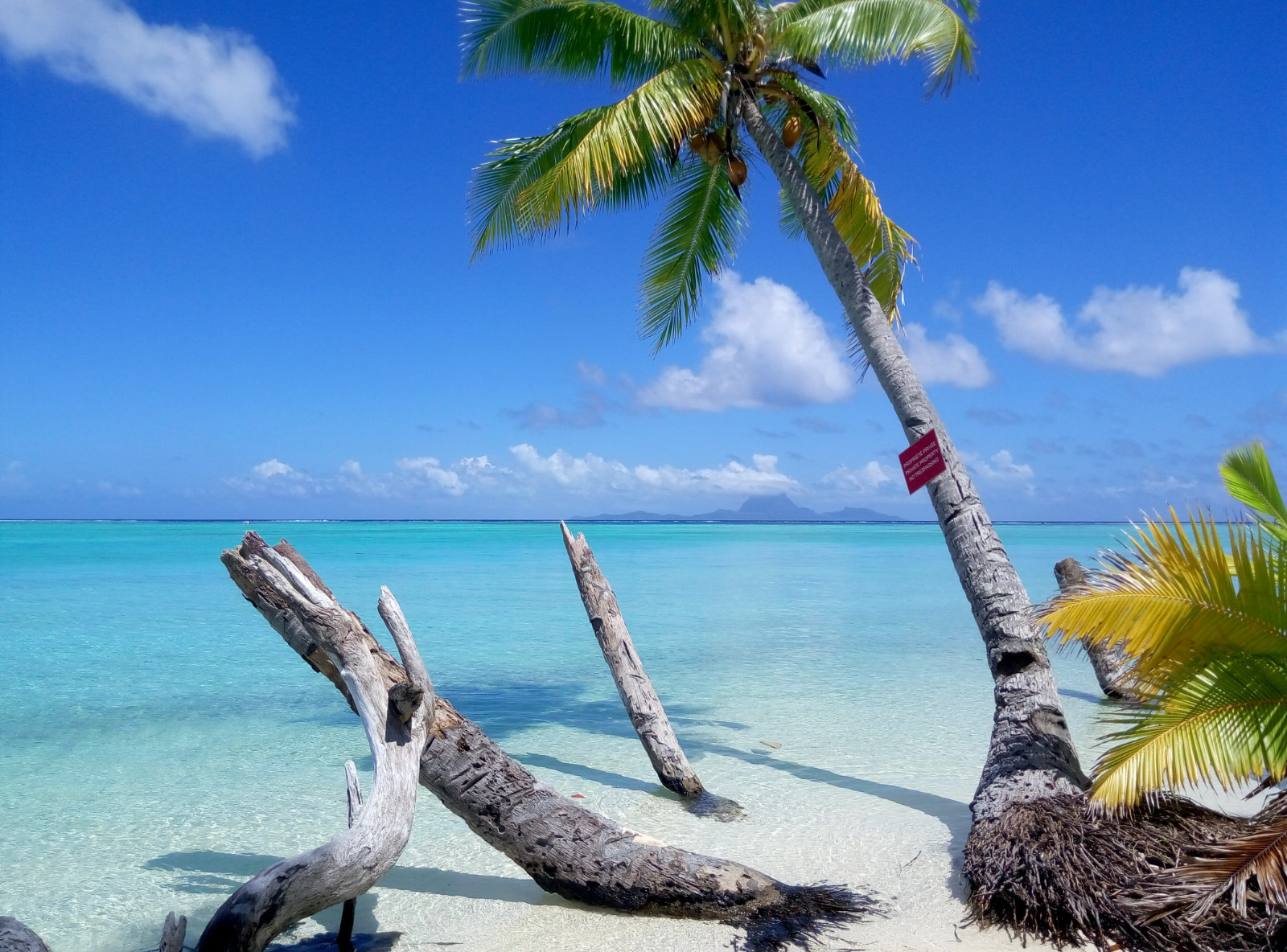
Le Taha’a A pier linking an isolated Relais & Châteaux property in the middle of the South Pacific
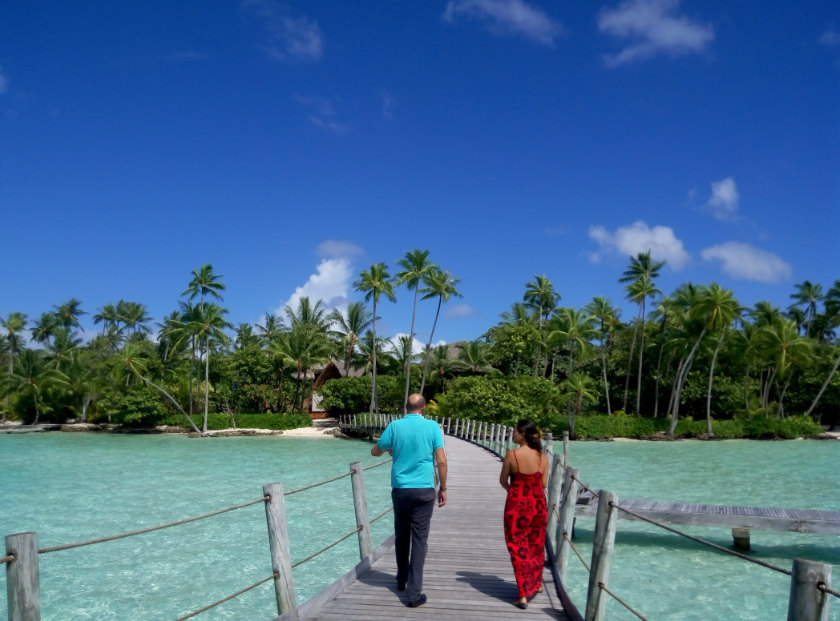
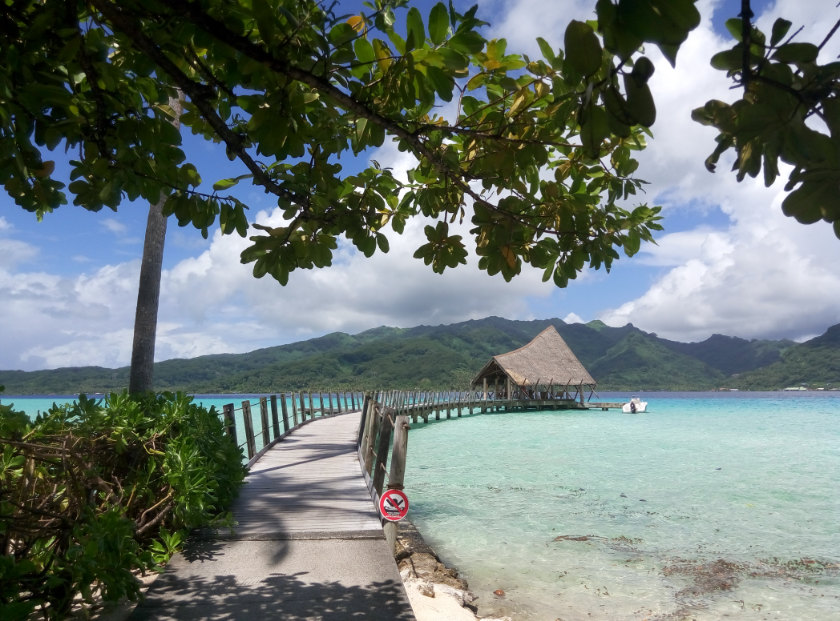

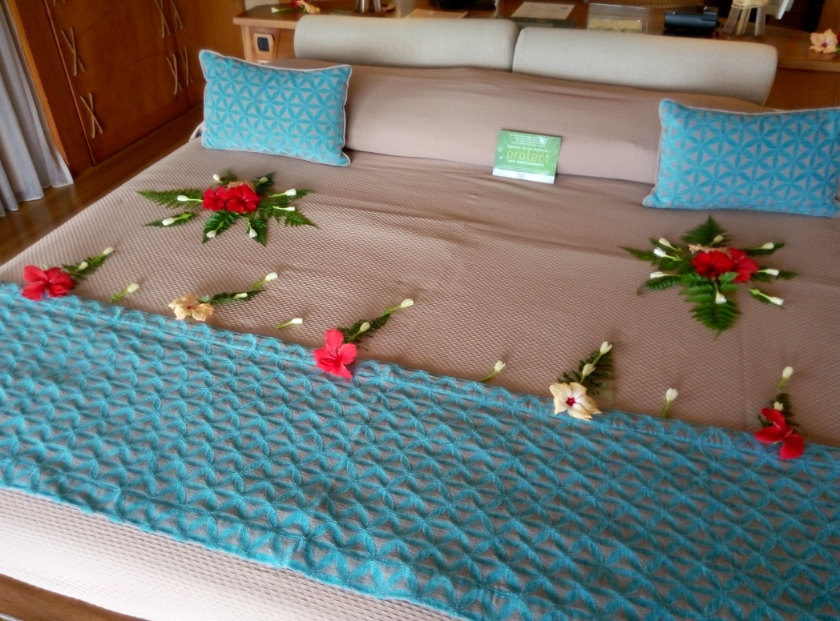
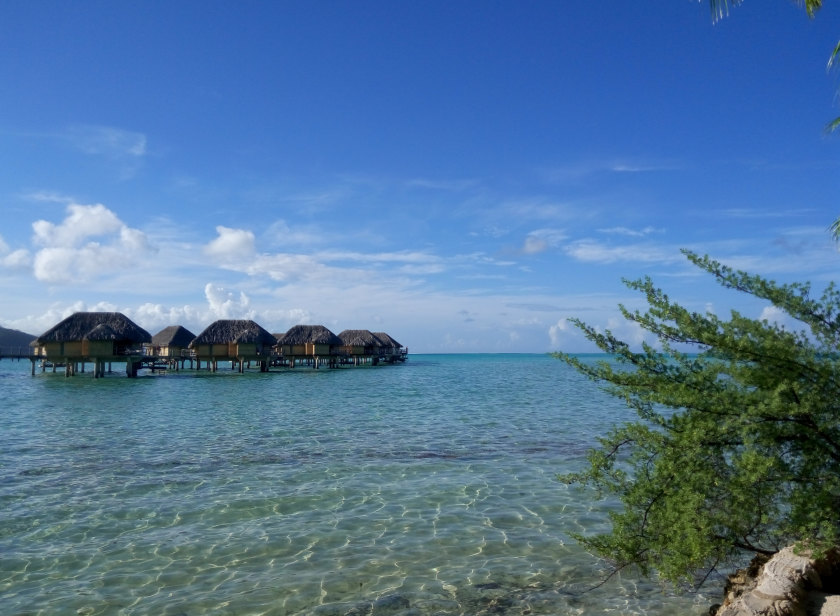
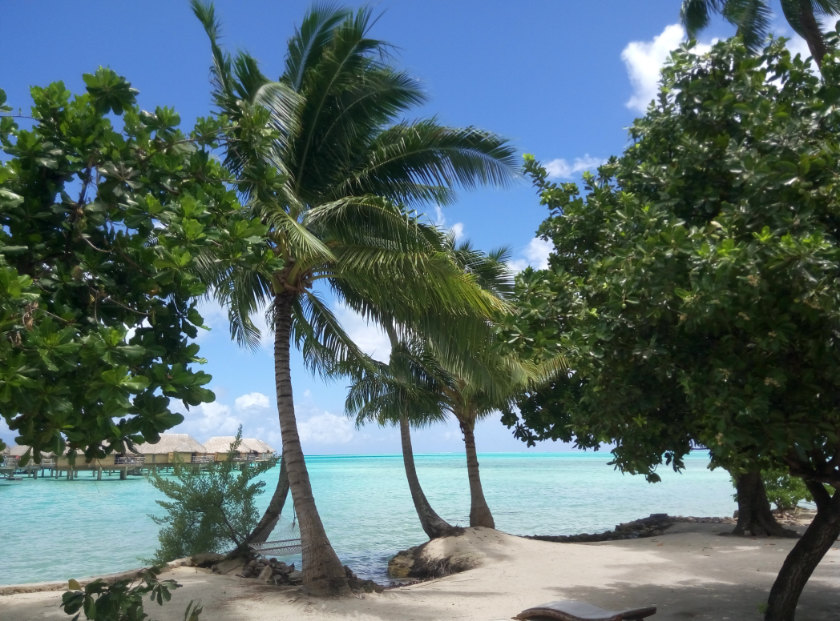
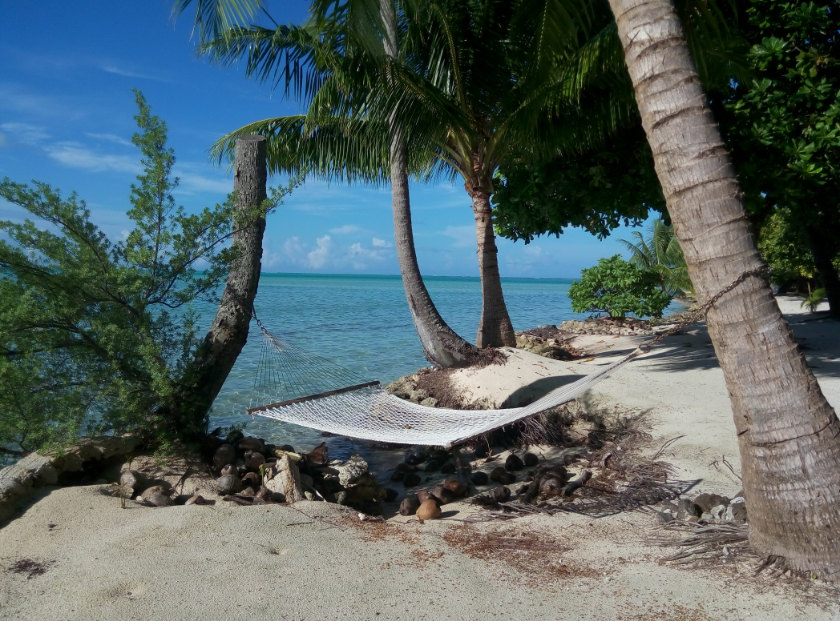 On land and over water
We chose to stay on land again when we got to Le Taha’a—and enjoy our own hammock
On land and over water
We chose to stay on land again when we got to Le Taha’a—and enjoy our own hammock
Reef sharks in this part of the world are human-friendly for the most part, and Ray drew them near by feeding them fish. The amount of sharks was far greater than we had witnessed previously; either Ray was more knowledgeable about their locations or the population had grown (the former is likely; he had a noticeable scar on his leg having survived a stingray attack). These sharks were uninterested in people and we were invited to dive in. Fortunately, too, Ray was equipped with sufficient life jackets (something we don’t recall from 2005), which allowed non-swimmers to enjoy being in the warm Pacific waters. Ray also had scuba masks for everyone. There was a coral reef nearby, filled with sea life, and thanks to the larger group, even less confident swimmers and non-swimmers felt safe heading into the water.
There were defence cannons on the island, too, that had been installed in the mountains during World War II, and Ray pointed out one of the eight that the US military placed there. This was en route to lunch on a motu, where members of Ray’s fanau were waiting, including his cousin, who was equally musically gifted and soon joined Ray in a duet. A second tour group was also there: there’s nothing like eating on a Pacific islet with a big group all happy to relax and have some kai together.
Home cooking, using local ingredients and flavours, can be unbeatable, and this was no exception. Steak, chicken and fish, along with watermelon, rice and potato served on coconut-leaf plates were sumptuous, and one of the fanau let slip that part of the secret was using fruit juice in the sauce. To impress us with their self-sufficiency and eco-friendliness, Ray showed us how to make the plates for ourselves and how to get the flesh out of a coconut. Exploring the motu, we noticed it was clean and cared for: where we ate was not a façade. They were serious about keeping everything clean and being conscious of the environment.
A stop on the way back saw a meeting with stingrays, and Ray explained that it was common to remove the barbs from the creatures (they grew back every three months). Most were quite content to swim with people in their shallow habitat, and they made their way around us. One was far less keen on being picked up by Ray so he could show us its mouth (on the underside) and the stinger itself.
There were a few more swims in the afternoon and it was tempting to think the sun, which felt warm and gentle, was not as harsh as what we would typically have in New Zealand. This is an error: it’s just as strong here and suntan lotion is a must.
We stopped at a point where the water changed colour, from a blue to a turquoise. This isn’t an illusion when you see it in tourism photos: it marks a change in depth. We got out to waist-deep water and enjoyed the final swim of the day before returning to our hotels.
It wasn’t the end of the unique Bora Bora experiences. This was Polynesian night back at the Pearl Beach Resort, with a buffet dinner and live entertainment from a group of dancers. The one-hour show was vigorous and energetic, with some more gentle numbers from the female members of the troupe, and to finish up the evening, we were invited to take photos with them as souvenirs.
Julien Bressolles, the general manager of the property, was a splendid host the following morning as he asked us what we thought of his resort. Trained in Switzerland, Bressolles was a very hands-on manager familiar with the changing trends in tourism, and very aware of how online media worked. He had been at Le Taha’a Island Resort & Spa, our next destination, but assured us we would be in good hands as his classmate, Laurent Campi, had his old job there.
Bressolles was clearly putting his stamp on the Bora Bora Pearl Beach Resort and Spa, very attentive to our feedback on the menu and facilities, and we had a sense he had a very positive reputation of being the sort of leader who would take hotels to the next level. It would be of considerable interest to see just how much more he can raise the resort’s already excellent levels on a future visit.
Bressolles and his team had us well looked after, with a handwritten note delivered to us the night before detailing when we would be needed to report at reception for our excursion back to Bora Bora Airport. There was a light breeze as we headed to breakfast, and it was pleasant to feel the wind as we sat close to the beach during breakfast. The check-out process was efficient and pleasant, and we felt that we were in the company of old-world hospitality, albeit in a paradise setting punctuated with tiaré (the local gardenia variety).
We were flying to Ra’iātea Airport, with Le Taha’a Island Resort & Spa our next stop. This was further west, and we were going more remotely than we ever had in this part of the world. Ra’iātea, in the local tongue, means faraway heaven, and given what we were to experience at Le Taha’a, it was very apt.
Once at Ra’iātea, the second-largest Tahitian isle and the home of Mt Temehani (792 m), the staff of Le Taha’a met us at the airport for a longer journey (35 minutes) by motor boat to the island resort. Those who wanted to charter a helicopter would have needed only 14 minutes from Bora Bora to Le Taha’a. The island of Taha’a is lush with vegetation, with the Tiva Protestant Church one very noticeable sign of western culture spreading itself to this hemisphere. We were going even further, to the Motu Tautau islet, in between Bora Bora and Taha’a island.
Nothing prepared us for the serenity of Le Taha’a. The jetty wound gently toward a shore covered by palm trees with the reception building camouflaged within. If we thought Bora Bora was quiet and romantic, we had to revise our ideas of what ‘paradise’ was considerably. We were on a private islet, with just this resort and private property on the other side. A Relais & Châteaux property—its flag flew proudly once we got near the reception building—we were confident that every whim would be cared for here. After all, Sofia Vergara and Joe Manganiello welcomed in 2017 here, and Carrie Underwood honeymooned here with her husband Mike Fisher. They can be guaranteed privacy.
Looking at an over-water suite first, again we noted the effortless blending of traditional and modern: like the earlier two properties, Le Taha’a is Tahitian-, not multinational-owned. A drawing of a boat was carved on the bathroom door, and other native art appeared on wood trim. Steps took us from the fare to the shallow water beneath, and there were glimpses of marine life through the downward glass around the suite. Flowers were placed lovingly on the bed and couch. The sun shone throughout, and the air conditioning was top-notch: we had noticed the temperature creep up a couple of degrees since Bora Bora, and this was a must. Two deck chairs beckoned.
However, our own suite on land was a perfect home for us. Outside, it looked harmonious, with hand-carved wood panels displaying its Tahitian heritage. On closer inspection it was more spectacular. A private plunge pool outside, quiet Gree air conditioning in the bedroom and a silent overhead fan if you needed it, an outside bathtub should we need it, and our own beachfront. The bathroom was decorated with native flowers. A hammock swung from palm trees outside. The added star—we were now in five-star luxury—was apparent, in the décor, the comfort of the bed, even the size of the TV screen. The comforting interior wood tones and the thatched roof added to the sense of calm.
The fare was bigger than the over-water one, with a smaller lounge–office linked by a small hallway from the bedroom if you needed a bit of space to do your work. It should be noted that as this is a place to get away, there is no wifi in the suites, and rightly so. It would only distract from the beauty of the place. Even though we had unwound at Bora Bora, here at Le Taha’a we were able to take that to the next level.
One of 57 suites on the property—the colourful general manager Laurent Campi explained that there were larger ones for families where there was a shared lounge but two bedrooms and hallways that we didn’t see—we were a short stroll back to the main buildings through a garden where Le Taha’a had ensured there was a stunning variety of local flowers, including orchids and tiaré. Leaves benefited from the oxygen here, which must be richer than elsewhere: they were incredibly large. A tree wound across the path, having grown without human impediment; Le Taha’a wisely preserved its windy branches and allowed it to follow its own will.
We grabbed a lunch at La Plage, and looked out at the pool. Couples were enjoying drinks at the Manuia Bar, where they could swim up and order. The staff had got word of our preference for gluten-free bread and had ordered that in advance, although our first meal was a simple tuna and rice.
Here, too, Le Taha’a had a commitment to the area’s ecology and used the Biorock process to develop coral and marine life. The gift shop, meanwhile, sold the Evoa sun tan, which had been deemed coral-friendly should you wish to head into the waters for a brief swim.
As the sun set, we experienced a very different view out of suite no. 56, of the over-water bungalows bordered by our palm trees, and the ocean beyond; after waking to Mt Otemanu each day at Bora Bora, this was a pleasant change and it only served to remind us of the isolation. It was a very welcome feeling.
Le Vanille restaurant’s wine list was fitting of a Relais & Châteaux property, though there was a fancier option called the Ohiri with an even more exclusive menu on offer. Spying certain Bordeaux wines retailing for €1,600 suggested to us that Le Vanille was fancy enough, and we could even opt for Oyster Bay or St Clair from the Marlborough region if we wanted. We had a simple Polynesian buffet, though given its price it may have been worth being more adventurous; however, it was also Polynesian night here, sporting one act that we didn’t see back on Bora Bora: fire dancing. It’s the pièce de résistance for this dance group, with one of the male dancers performing the dangerous moves as we gathered to watch on the beach.
Breakfast was also at Le Vanille, again a buffet which allowed us to fuel up for the day ahead. The birds were happy to come closer to those of us who sat by the beachside seats, awaiting five-star morsels. Le Taha’a staff, including one member of the team fluent in Japanese, happily arrange tours and we organized a half-day trip on the main island, five minutes’ boat ride away.
continued below
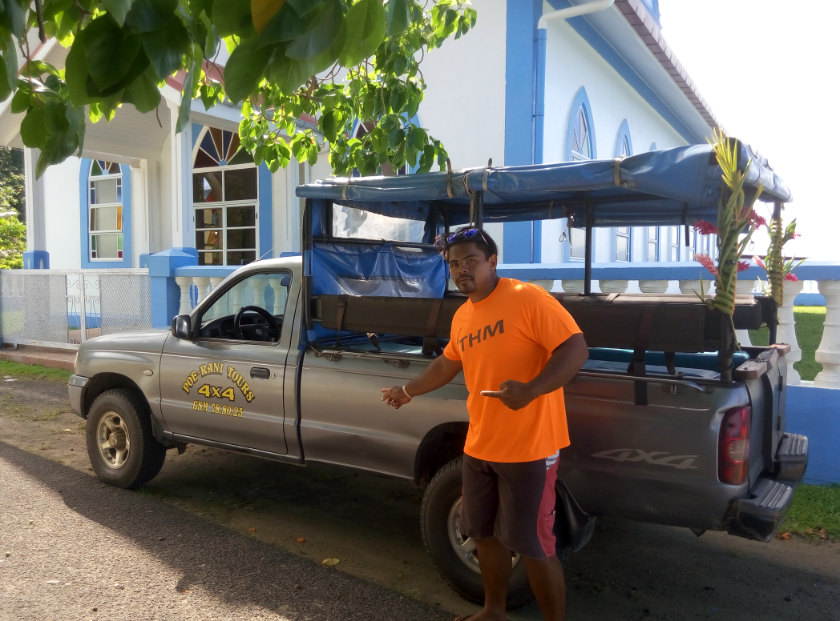
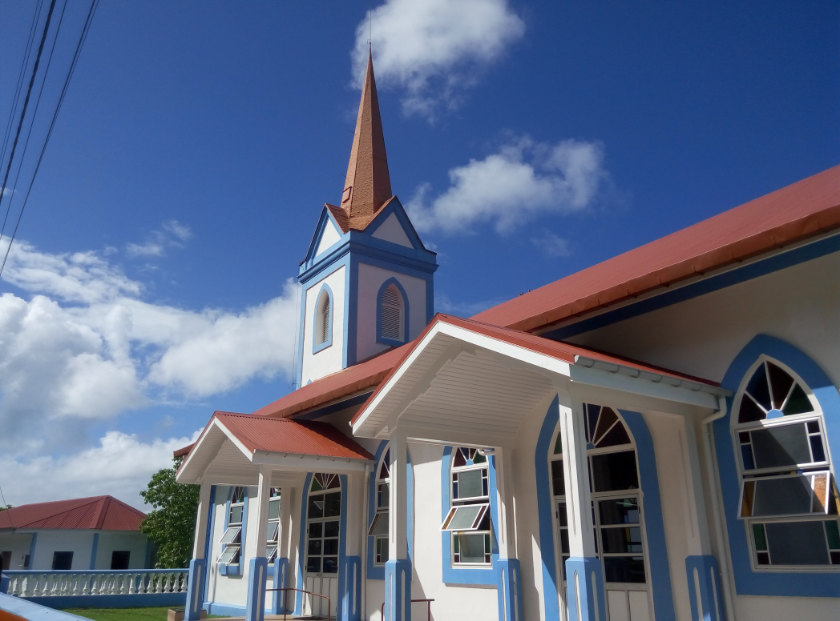
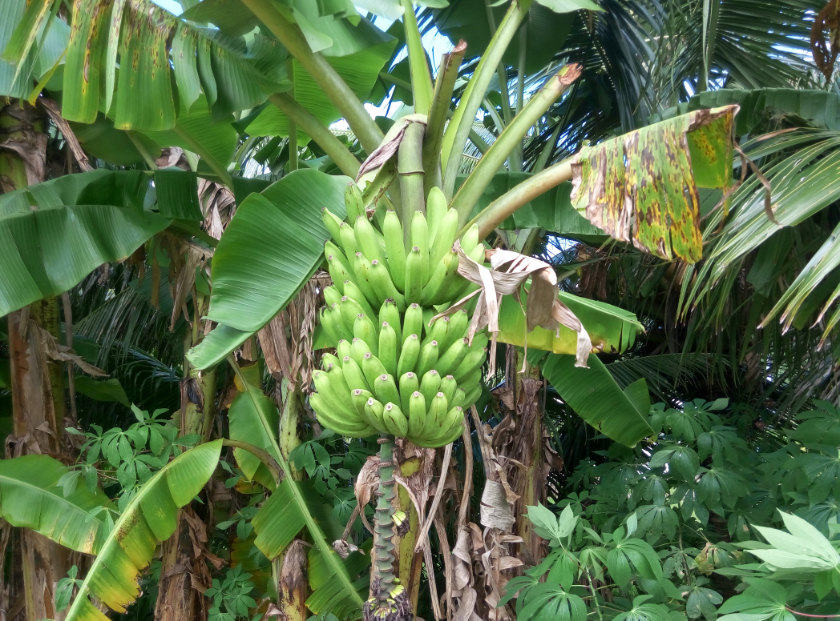
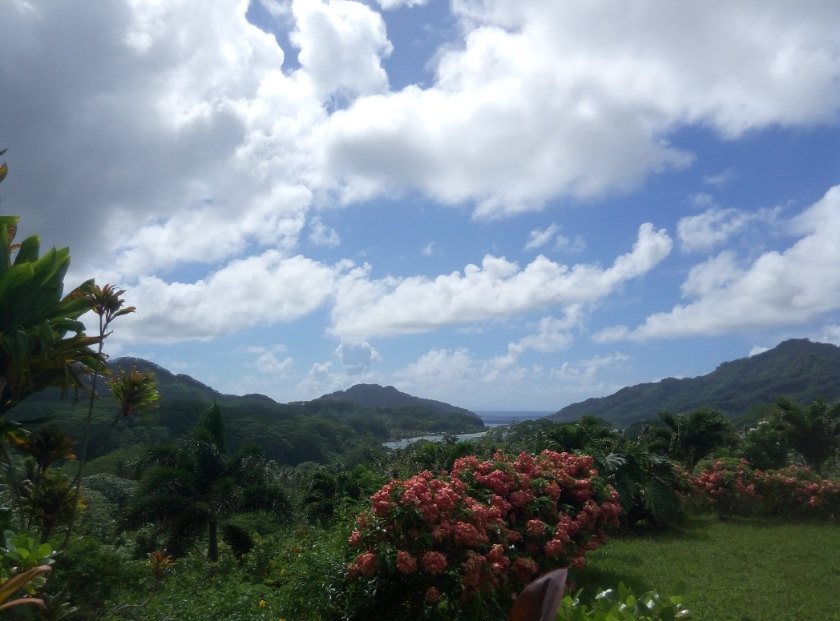
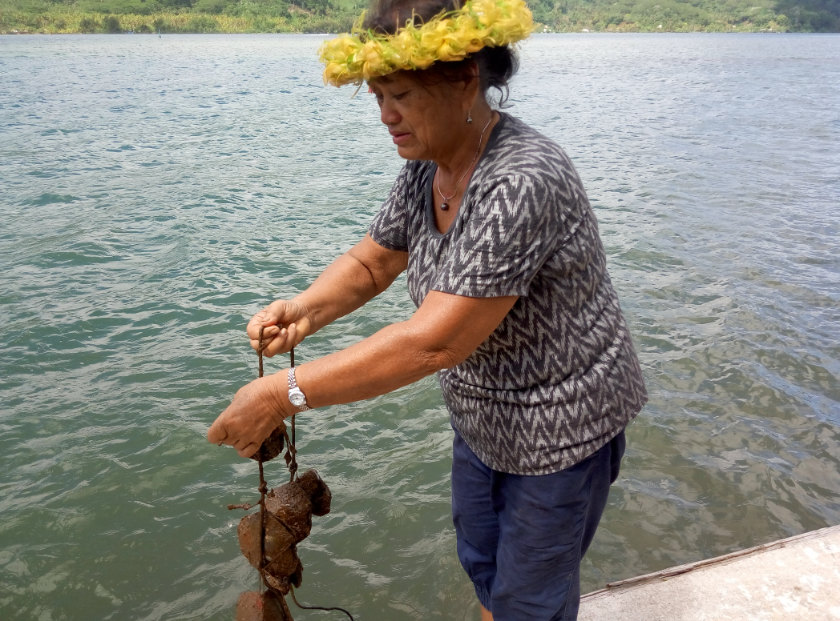
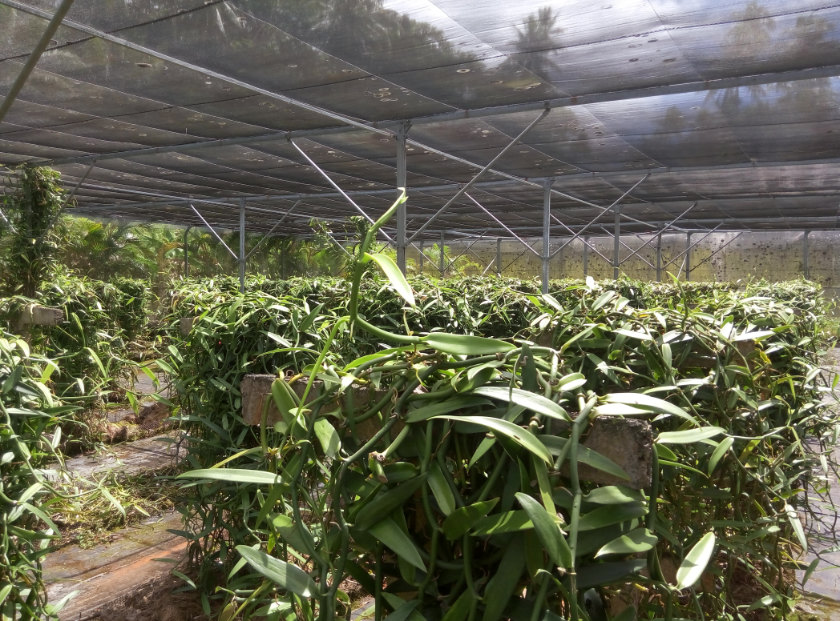
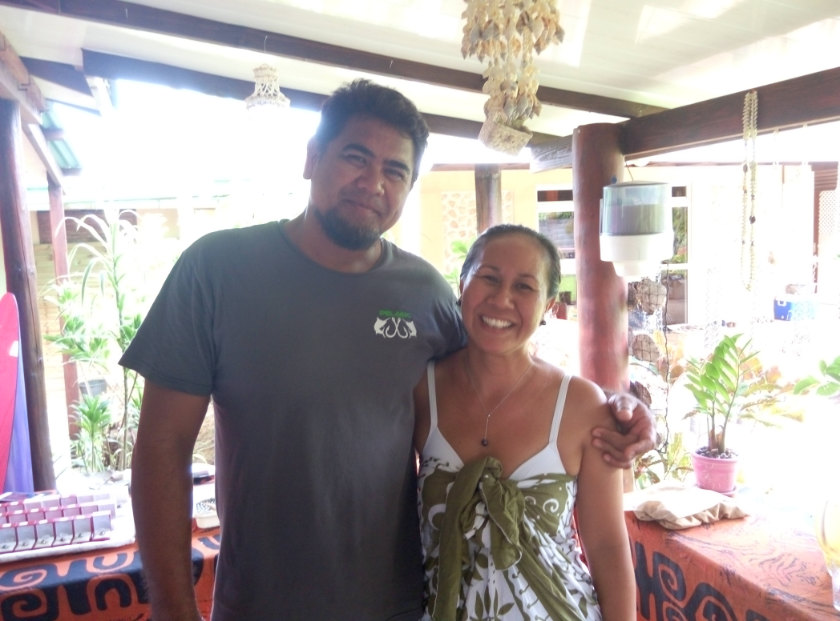
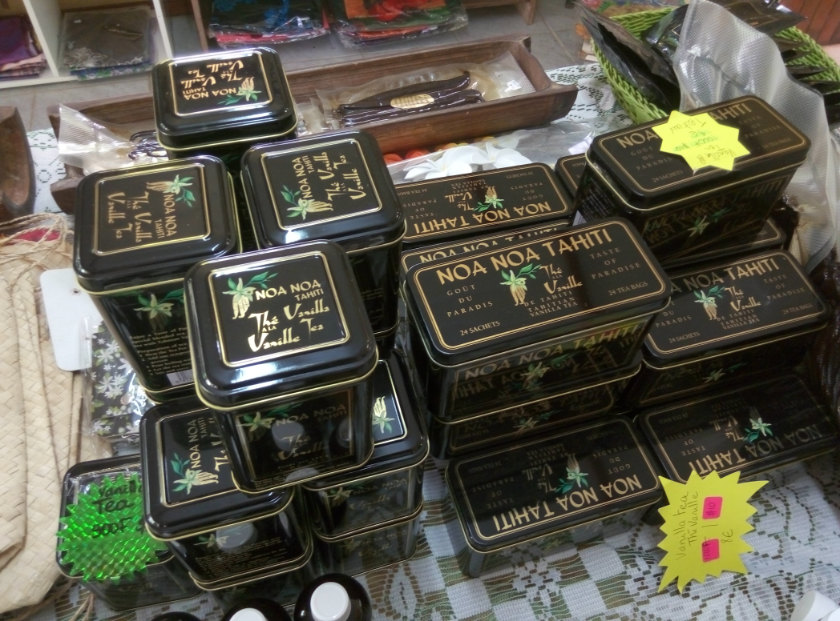
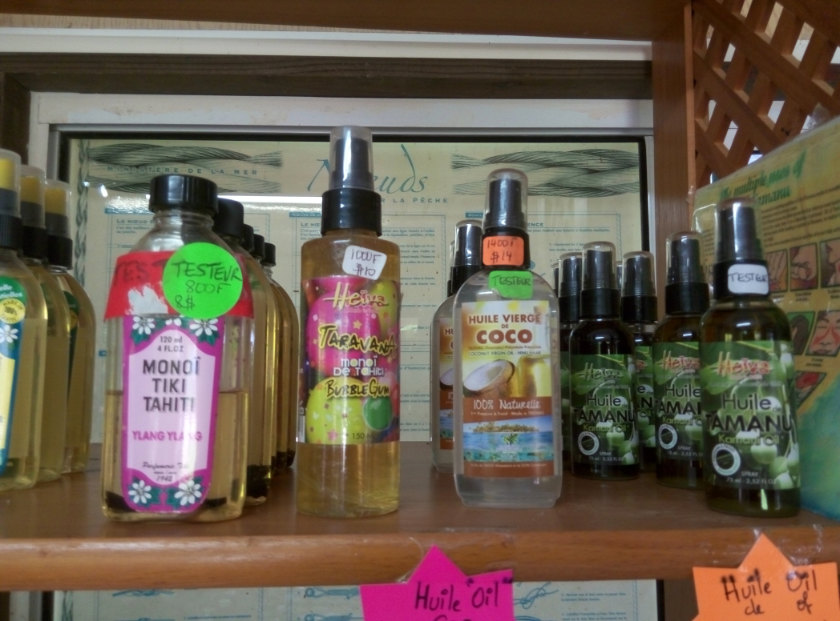
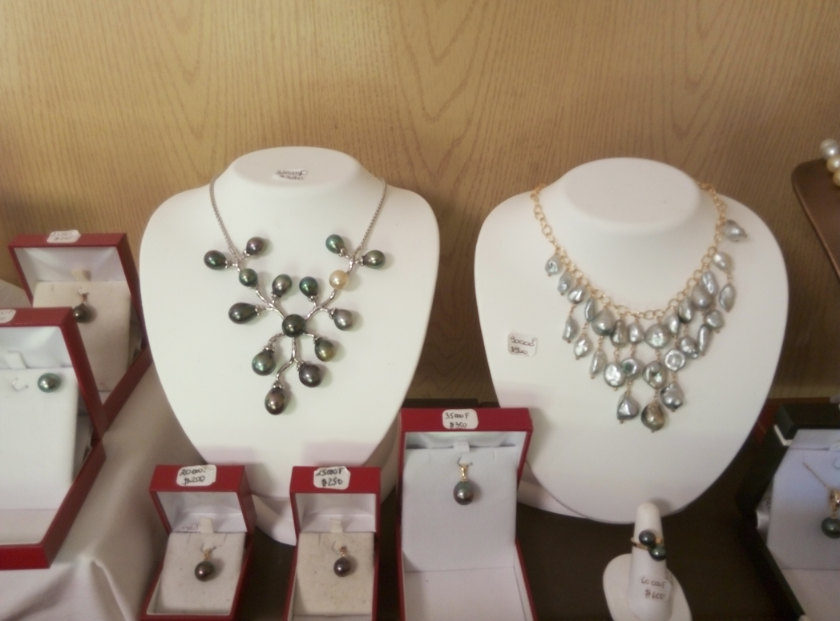
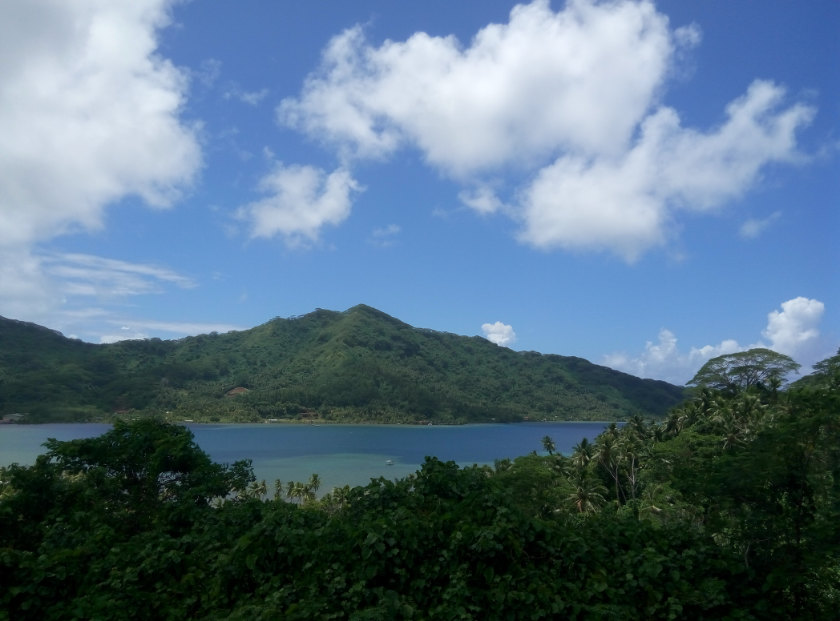 Touring Taha’a, away from the resort, above from top: Aro and his Mazda truck. Tiva protestant church. Banana trees aplenty. View from Taha’a, with Vahine in the distance. Jacqueline explains pearl-farming. A vanilla farm on Taha’a. Poerani proprietors Teva and Linda. Vanilla tea, oils and jewellery at Teva and Linda’s home. At Fa’a’aha.
Touring Taha’a, away from the resort, above from top: Aro and his Mazda truck. Tiva protestant church. Banana trees aplenty. View from Taha’a, with Vahine in the distance. Jacqueline explains pearl-farming. A vanilla farm on Taha’a. Poerani proprietors Teva and Linda. Vanilla tea, oils and jewellery at Teva and Linda’s home. At Fa’a’aha.
Aro, our cheeky guide with Poerani Tours, welcomed us and helped us into the rear of his Mazda pick-up truck, or, as he jokingly referred, his ‘limousine’.
Life on Taha’a is simple but the island is abundant with fresh fruit and vegetables: you literally can pull over, find an errant coconut that had fallen, and make a meal of it. Aro explained he had bananas growing freely on his property, and brought them for a picnic for us. Papaya and banana trees were commonplace here, but what Taha’a is also known for is its vanilla and pearls.
We travelled on our first road for some time—there are none on Le Taha’a—and headed to our first stop of the Tiva protestant church, which we had spied on the way in. Closed to the public on this weekday, we were nevertheless allowed to walk around the property.
Aro found some miro fruits, which were used for insect bites; demonstrated the sensitif plant (mimosa pudica) whose leaves fold forward when touched; found ferns which could leave temporary, white tattoos on skin (he noted that the fern resembled the New Zealand national symbol); and showed off the ylang ylang, which grows naturally on Taha’a—he proudly noted it was an ingredient in Chanel No. 5. The colours of the plant life were exotic: we looked at a private garden with red, peach, lilac and pink flowers.
There was more exotic fare to come, as we visited Jacqueline, an older, part-Chinese Tahitian woman (the Chinese form a large part of the population in the islands, and it’s common to meet people with Chinese heritage), who explained the niceties of pearl farming and pearl cultivation, and the years it takes to harvest a single pearl. This was part of Poerani’s many businesses, and Jacqueline was the matriarch.
The pearl-farming business had been set up by her and her husband and has now passed down to her son, Tiva, and his partner, Linda. Among its activities aside from the tours was vanilla farming. The pearls themselves were of varying qualities, and Jacqueline was all too happy to try to sell some of the stock. But we weren’t quite ready to make impulse purchases.
Aro then drove us to a vanilla farm and demonstrated how the pods were fertilized, laboriously done by hand. The plants are hermaphrodites, but require outside help to pollinate.
Despite the labour-intensive work the industry has been thriving, and we were delighted to meet Tiva and Linda at their home and studio.
This was where we decided to shop and get some local produce, from vanilla plants and tea to tamanu oil, the all-purpose, natural oil known to help with skin care, alleviate pain, and regenerate skin. There were even more pearls for sale here, and Linda noted that her brother was also in the business in the nearby Gambiers Islands, where reputedly the best pearls come from. Tiva, meanwhile, was painstakingly at work on new jewellery.
Other scenic spots on the island included Fa’a’aha, a small bay with a peaceful mountain view, in contrast to the vast ocean expanses we enjoyed at the resort.
There were, sadly, a lot of 1990s’ French hatchbacks lying wrecked on many properties. Aro explained that some models had proved unreliable (we later learned that they couldn’t stand the heat), and the cars were left unloved. This prompted the shift to Asian vehicles, and he was particularly proud of his work’s Mazda truck.
He was also proud of his ability to use his teeth to remove a coconut’s skin, something which took under three minutes. As entertainment, it was enjoyable, and we had the treat of coconut water and flakes afterwards, accompanied by fresh bananas (which are tastier here).
The local Chu Supermarket, however, was less impressive, reliant on shipments from elsewhere, and stocked plenty of frozen and processed foods. It was our last stop before Aro returned us to the port where the single petrol station we saw on the island was located, and Le Taha’a had another vessel at the ready to take us back to our resort.
We needed an afternoon meal, and vowed we would swim and order chocolate ice-cream poolside at the Manuia Bar. With very few guests on hand and a very high staff-to-guest ratio, we were spoiled. Room service, too, was excellent, again with our dietary requirements catered for. By this point we felt that the staff all knew us and our specific requirements, and most of the La Plage and Le Vanille crew were able to suggest the drinks we had ordered many times before. Young French interns, Théo and Emma, were enthusiastic about being so far away from home and were particularly attentive to our needs.
Walking to the end of our beach and past other fare, we could spy Bora Bora in the distance, and a ‘No trespassing’ sign as we reached the end of Le Taha’a’s property. We felt the extreme serenity here: we were at the edge of an already isolated resort on a private island, reaching a point where other visitors might not head to as they enjoyed the amenities within.
We didn’t sample the gym though Campi showed us the facility, with monoi oil at the core of the spa’s treatments. Those enjoying Le Spa at Le Taha’a would enjoy a view of the laguna with bamboo trees alongside the water. And a refreshingly cool business centre, with a big-screen TV at the end, wound up being the best wifi spot at the resort if you needed some connection to civilization.
And, sadly, civilization, or at least a more populated urban centre, was what we had to return to. Holidays need to come to an end, and almost on queue, we hit the first prolonged wet patch since being on the islands. Away from being cosseted at Le Taha’a, the café at Ra’iātea Airport was shockingly uncooperative, and we hit more wet weather as we headed into Huahine, then Papeete. Our driver, Mana, said that the weather had become unpredictable and we discussed global warming. The Tahiti Pearl Beach Resort was our home on our last night in French Polynesia, hosting our third Polynesian night, with its own charm, different from the earlier two. Celestine and Dimitri attended to our dinner, again creating something that wasn’t à la carte, but tailored to our tastes. A regular artisans’ market saw carving and jewellery from other parts of Tahiti: it was a sign that we were back in "the big smoke". We knew we had been blessed to get the summer we craved—and only wished it could have been longer as we returned on one of Air Tahiti Nui’s newest planes, with plenty of movies and documentaries on board to remind us there was a world outside of paradise. •
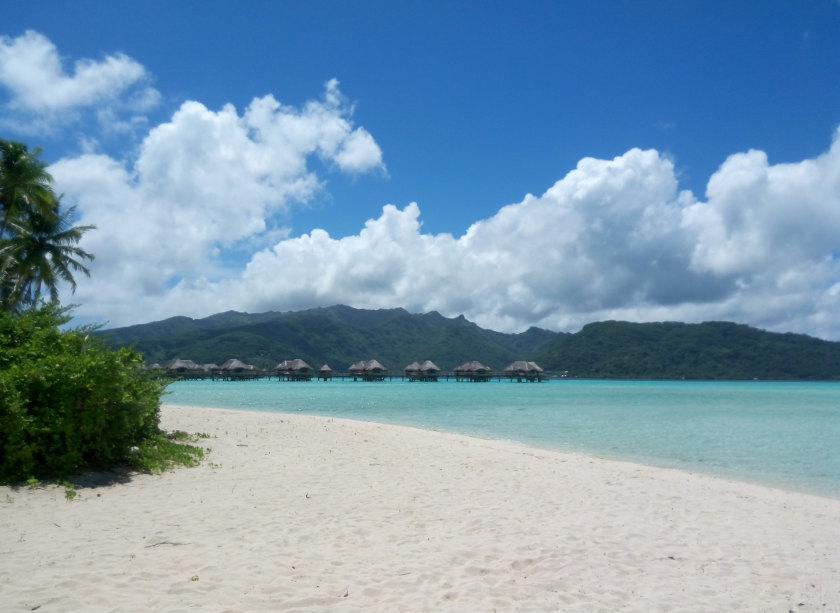
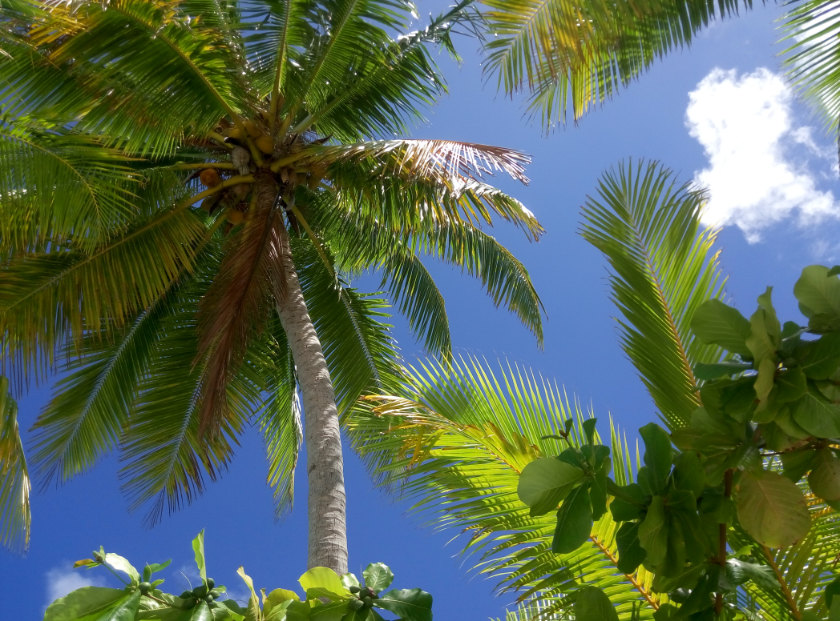
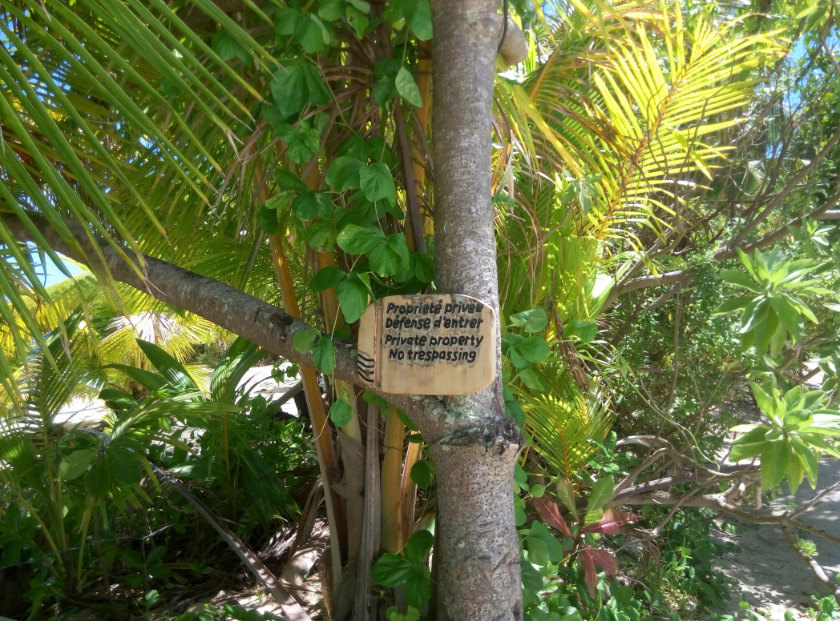
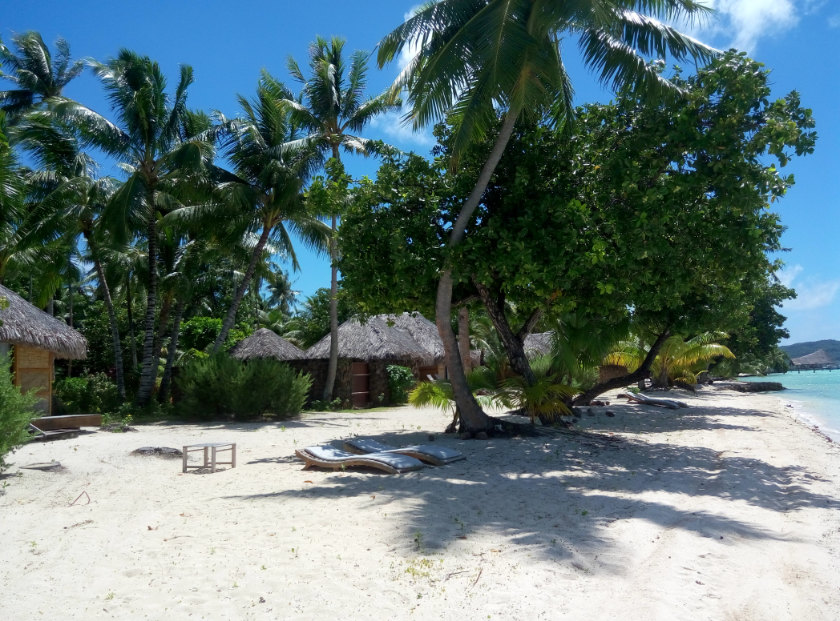

Views from Le Taha’a A Relais & Châteaux property, Le Taha’a has an expansive beach—though you do reach a point at the very end where your half of the private island ends. Above: the view from the spa.
Related articles hand-picked by our editors
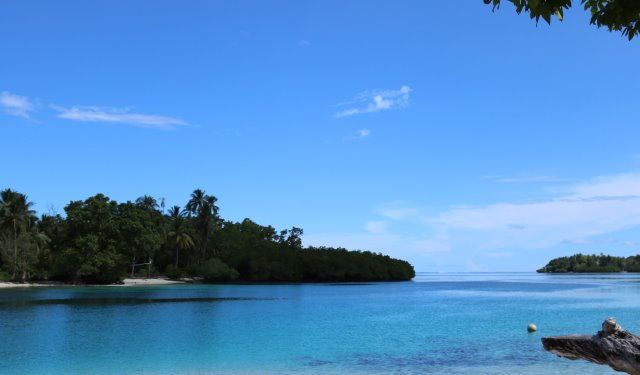
Under the spell of the Solomon Islands
The Solomon Islands make for the perfect honeymoon escape, as Alex Barrow discovers
Photographed by the author
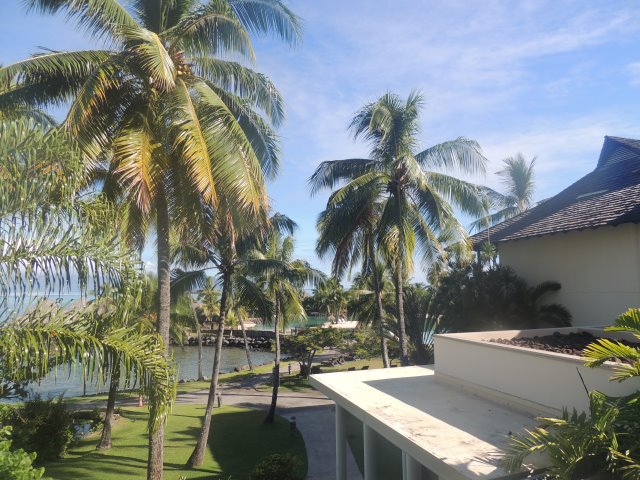
Earthy luxury in French Polynesia
From Bora Bora’s posh, polished pearl boutiques to Tahiti’s urban beach scene to the rough-hewn elegance of resorts on her other islands, there’s something for every taste
by Elyse Glickman
Photographed by the author
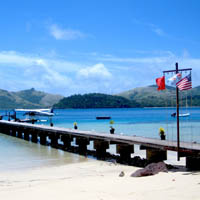 Fiji: just like the movies, only better
Fiji: just like the movies, only better
The multicultural archipelago nation, incorporating the real-life Blue Lagoon, is as surprising as it is romantic by Elyse Glickman
Advertisement
Copyright ©1997–2022 by JY&A Media, part of Jack Yan & Associates. All rights reserved. JY&A terms and conditions and privacy policy apply to viewing this site. All prices in US dollars except where indicated. Contact us here.